Welcome to peterboyd.com
Peter D. A. Boyd
A Personal Crusade in Search of Scots Roses
Peter D. A. Boyd
Web version of
BOYD, P.D.A. 2005. 'A Personal Crusade in Search of Scots Roses' / 'Ein persönlicher Kreuzzug auf der Suche nach Dünenrosen'. Rosenjahrbuch 2005, Verein Deutscher Rosenfreunde e. V., Baden-Baden, Germany. pp. 117-129.
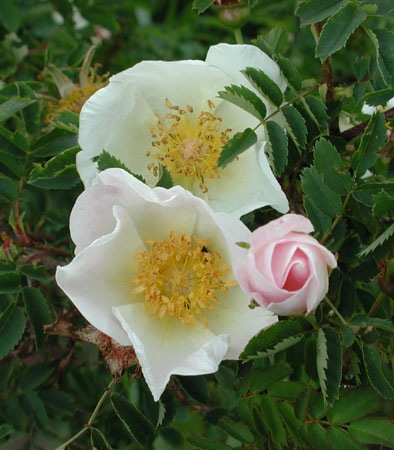
A Rosa spinosissima hybrid seedling from the author's garden.
Introduction
Scots Roses are cultivars of Rosa spinosissima (also known as Rosa pimpinellifolia) and some hybrids of the species that have a similar character. I grow them in my garden which is situated in the Shropshire Hills at an altitude of over 300 metres, close to the border between England and Wales. It is a new garden being created from several hectares of rough and exposed hillside resembling parts of Scotland. I have many gardening interests but one of these is collecting, growing and researching Scots Roses. I am fascinated by the history of this group of roses which was very fashionable in the early nineteenth century but which is now unknown by many gardeners.
The Scots Roses in my garden give me a lot of pleasure because of their charm and their ability to thrive in quite harsh conditions. They also remind me of the people that I have met and the places that I have explored in searching for them.
I have been interested in Scots Roses since the 1960s when a family friend gave me a piece of a Double White Scots Rose from a garden designed and planted by Gertrude Jekyll, a well-known British gardener. Pieces of this rose have travelled with me from garden to garden over the last 40 years and it is still one of my favourites. In 1966, I went to Aberdeen University in northern Scotland to study Botany and Geology, and through studying these subjects became familiar with wild and isolated parts of Scotland as well as the more genteel cultivated places. I married my wife Evelyn in Aberdeen in 1969. We spent several years exploring wild parts of Scotland and sometimes discovered wild forms and old cultivars of Scots Roses still growing by deserted ruins. Cuttings from these plants, a gift of cuttings from the Royal National Rose Society garden at St. Albans and the purchase of those cultivars obtainable from British nurseries in the 1970s, increased the collection to a dozen or so.
These roses (or bits of them) were moved from garden to garden as we moved around the British Isles over the years. However, it was only in 1997, after we moved to our present home in Shropshire that I decided to develop a more active interest in Scots Roses again. I started making more regular trips to Scotland as our son had become a student at St. Andrews University and I took the opportunity to add a little time to each trip to explore old gardens in search of Scots Roses. After my son graduated from St. Andrews, I decided to continue my trips up to Scotland in June when the roses were in flower and return in October having obtained permission to collect suckers of my 'found roses'.
A beautiful semi-double marbled pink Scots Rose found by the author near Peebles, Scotland.
The publication of Mary McMurtrie's book on Scots Roses in 1998 encouraged my quest for old cultivars. The publication of her book was a surprise and a delight – I did not realise that anyone else was interested in Scots Roses! Her book provided the names of other Scots Rose enthusiasts including Iris Strachan and Dr Peter Waister who I was able to contact as well as Mary herself and her family.
Mary McMurtrie's Scots Roses of hedgerows and wild gardens (1998) is, currently, the best source of illustrations of Scots Roses. It includes reproductions of Mary's beautiful watercolour illustrations and descriptions of 67 cultivars. Mary was born in June 1902 in the village of Skene, Aberdeenshire, Scotland and died in the city of Aberdeen, on the 1st November 2003, in her 102nd year. She was the oldest working artist in Britain, the widow of a church minister, a nurserywoman, mother of four children and grandmother to 17. She published her first illustrated book The Wild Flowers of Scotland in 1982 when she was 80. She painted flowers in Scotland, Kenya and the Algarve.
Mary McMurtrie, author of Scots Roses of hedgerows and wild gardens at 100 years old.
Her book on Scots Roses was published in 1998 (when she was 96 years old) and, like her other books, it is illustrated with her charming watercolours. However, the book came not only from the brush of a highly accomplished artist but also from the pen of a plantswoman who ran a successful nursery specialising in alpines and old-fashioned plants until her 'retirement' in her 80s. Her Scottish Wild Flowers was published in 2001 and her final book, Old Cottage Pinks, was published in January 2004 two months after her death. Unfortunately, I did not meet Mary until she was 98 years old. Although I had started to collect Scots Roses over 30 years earlier, the publication of Mary's book had contributed to my renewed interest in them. I visited Mary and members of her family several times at their home near Aberdeen and last saw her in June 2003. Although she had become very deaf, her eyesight was still excellent (she painted without the need for spectacles), her brain as bright as ever and her character as delightful as the Scots Roses that she painted. I have fond memories of afternoons spent talking about Scots Roses with Mary and her daughter Elspeth Haston (who is also a collector of Scots Roses).
A fine double pink Scots Rose found by the author in Aberdeenshire, Scotland.
In the course of my trips to Scotland and elsewhere, I have met many interesting people and made new friends who have been very kind to me. My collection of Scots Roses has been enlarged through the generosity of individual private gardeners, the owners or Head Gardeners of large historic gardens and through purchasing roses from nurseries in Britain, Finland, Denmark, Belgium, France and elsewhere. I have built up what I believe to be the largest collection of Scots Roses in Britain (about 200 cultivars plus numerous seedlings) but my research into the history of Scots Roses has shown that, in the past, there were over 600 named cultivars available from nurseries – even more than realised by previous writers.
British nurseries now only stock about 20 cultivars of 'Scots Roses' but some of these are the same cultivar sold under different names and, in other cases, different cultivars are sold under the same name. Also, some 20th century hybrids of Rosa spinosissima, such as 'Frühlingsgold', are sold as 'Scots Roses'. Roses of the Frühlings Series and other modern complex hybrids are beautiful roses but they do not have the same character as the 19th century Scots Roses which are closer to Rosa spinosissima in foliage, habit and other characteristics. Even the old and popular 'Stanwell Perpetual' (1838) is a complex hybrid and lacks the character of a true Scots Rose.
My collection of Scots Roses has been submitted to the National Council for the Conservation of Plants and Gardens (NCCPG) for National Collection status. It is my ultimate aim to be able to make properly named cultivars of Scots Roses available to Botanic Gardens and for propagation by nurseries so that the old varieties are not lost and can be obtained by modern gardeners. However, my research has not only been concerned with surviving cultivars of Scots Roses. I am writing a book on their history and nomenclature that aims to be a fully referenced 'definitive' source of information for garden historians and rose lovers. I have derived a list of nearly 700 names of Scots Rose cultivars from 18th, 19th, 20th and 21st century nursery catalogues, rose books and other publications and I intend that my book will include a listing of all the known old and more modern cultivars, with descriptions of each cultivar where known. Work on my book continues and is nearing completion but, in the meantime, I have tried to tell people about Scots Roses and the preliminary results of my research though publication of articles for appropriate journals and web versions on my website at www.peterboyd.com .
In the course of my research, I contacted Dr Volker Wissemann of the Institut für Spezielle Botanik der Universität Jena about his work into the genetics of wild Rosa spinosissima which he carried out while working at The Natural History Museum in London and told him about my own work on cultivated forms of this species. He kindly provided me with copies of his published papers on Rosa species.
The following year (2004), I was pleased to receive an invitation to visit the Europa- Rosarium at Sangerhausen. The invitation came from Dr. Volker Wissemann and Frau Hella Brumme, Director of the Europa-Rosarium. The Stiftung des Vereins Deutscher Rosenfreunde was prepared to fund my visit to assist with the identification of Rosa spinosissima cultivars in the collection. I was delighted – but a little apprehensive! I visited the Rosarium in late May 2004 and was made very welcome by everyone that I met in Sangerhausen. As my German language skills are poor, I was very grateful for the patience and good English language skills of Dr Wissemann, Frau Brumme and her colleagues who made my visit so fruitful and pleasurable. However, before writing in more detail about my visit to the Europa-Rosarium, I wish to examine some features of Scots Roses and their history to place my visit in context.
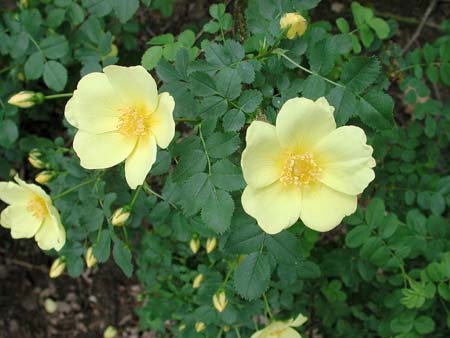
A Rosa spinosissima x R. foetida hybrid in the Europa-Rosarium.
The character of Scots Roses
Cultivars of Rosa spinosissima are now known as 'Scots Roses' or 'Scots Briars' but, when they were most popular, in the early 19th century, they were known as 'Scotch Roses'. Rosa spinosissima (also known as Rosa pimpinellifolia) is one of Britain's native wild roses. While the name Rosa spinosissima is the name used in many parts of Europe and in North America, Rosa pimpinellifolia is currently the name favoured in Britain. Scots Roses are sometimes known as 'Pimpinellifolias', with slight adjustment in the spelling for different languages, but those sharing the term need to know whether they are referring to just Rosa spinosissima or also related roses such as Rosa sericea in the Pimpinellifolia Group.
Scots Roses are 'cheerful' little roses and they have a special character that is very appealing. Although the individual flowers are only about 5cm (2 inches) across, they are usually produced in such abundance that a single shrub can be spectacular and create a halo of perfume. They like full exposure to sunshine, they are very hardy, will thrive in poor sandy or stony soils and, when established, they are resistant to drought. The sweetly scented single white flowers are on borne on prickly stems with small leaves and most forms have a spreading suckering habit. However, the flowers are not always white and supposedly isolated wild populations include plants possessing flowers in cream, pink or more intense colours. Whether all of these colours can arise naturally within the species or whether some arise from pollination with other species with coloured flowers is a matter of debate. The colour of stems, bristles, thorns and foliage can also be very variable in wild populations and give rise to attractive 'selections' but the heps of the species are normally rounded and such a dark purple that they appear to be black.
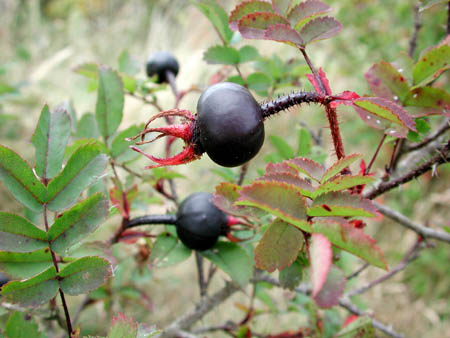
Black rounded heps are typical of Rosa spinosissima but the shape can vary and many cultivars have a smooth pedicel (fruit-stalk).
However, selection of seedlings from wild and cultivated forms has given rise to even greater variation than has been observed in the wild. These include cultivars with single, semi-double and fully double flowers in white, cream, yellow, pink, red, purple and mauve including subtle combinations of colour and some with distinct mottled, marbled or striped petals. Cultivated forms may also exhibit considerable variation in colour and shape of heps that, with other features, indicate a hybrid with another species or a garden rose that might itself be a complex hybrid. Some wild and cultivated forms also provide spectacular autumn colour in yellows, oranges, reds and purple. Scots Roses flower profusely for a relatively short period and then they are finished until the next year (as with most species and many old rose cultivars). In the case of Scots Roses, the main flowering may be in May, June or July depending on the particular cultivar, whether it is an early or late spring and the latitude or altitude of the garden. They do not flower throughout the summer like many modern roses but those that flower earliest may also have a few flowers in the autumn. However, they provide an extended period of interest in the garden with their attractive foliage, which may colour well in the autumn, and their shiny black heps.
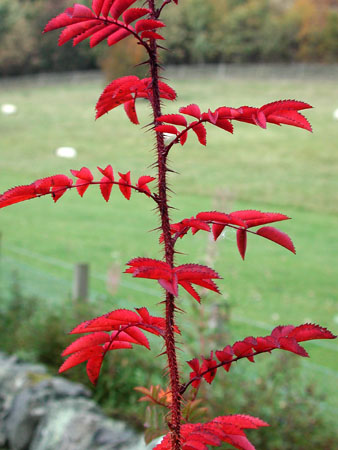
Autumn colour in a Rosa spinosissima cultivar.
I understand that nurserymen who propagate their roses by budding suffer a high failure rate with some cultivars of Scots Rose. However, they are quite easy to propagate from suckers or cuttings and Scots Roses belong to that group of 'cottage garden' plants that have been passed on from one garden to another between friends. A particular cultivar may therefore be quite common in one area but unknown outside it. However, they are usually known only by the name of the person who gave it or the place from which it came.
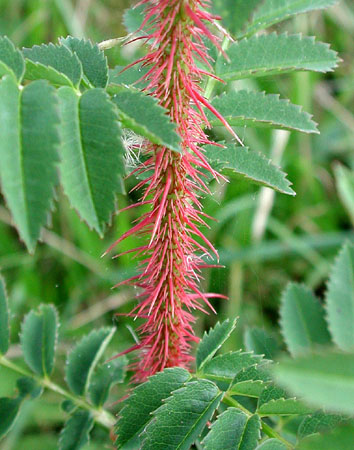
Detail of the young stem of a Rosa spinosissima cultivar, similar to 'Hispida'.
A short history of Scots Roses
The only Scots Roses that appear in nursery catalogues before 1800 are the single white, a single red and one with single marbled or striped flowers. Although I suspect that a 'Double White' may have arisen in the wild or a garden long before then, there is no evidence that it was available through nurseries. The first double-flowered Scots Roses were supposedly raised in the nursery of Messrs. Dickson and Brown (later Dickson and Turnbull) of Perth. In 1793, Robert Brown and his brother transplanted some of the wild Scots Roses from Kinnoull Hill into the nursery. One of these bore flowers slightly tinged with red and a seedling raised from that plant bore flowers with more petals than normal. Through a repeated process of sowing seed and selection from the seedlings semi-double forms were obtained and by 1802 and 1803 they had eight good double varieties to propagate and sell. The nursery of Dickson and Turnbull in Perth no longer exists and most of the land occupied by the nursery on the western slopes of Kinnoull Hill down to the Tay was built upon many years ago. However, part of the nursery land adjacent to the River Tay, south of the ruins of Kinnoull Kirk is now a public park but without any Scots Roses.
In about 1805, Robert Austin of Austin and McAslan, Glasgow nurserymen, obtained plants from the Perth nursery and, by about 1820, had raised about 100 new varieties of double Scots Roses. By the mid 1820s, Robert Austin had raised and offered for sale over 200 varieties. Other nurserymen in Scotland and England raised other varieties of Scots Roses. Most of these nurserymen, including several on the outskirts of London, were ex-patriot Scots or of Scottish descent and it seems to have become a matter of Scottish pride to raise or sell Scots Roses.
Many Head Gardeners of large private estates in England, Wales and Ireland were also Scotsmen. Scotsmen had been favoured in these positions since the eighteenth century. Therefore, it is not surprising that many large landowners in England had collections of Scots Roses either because of their own taste or because of the influence of their Head Gardener. Perhaps the largest of these collections was in the garden of Woburn Abbey, the home of John Russell, 6th Duke of Bedford, who was a passionate horticulturalist and whose Head Gardener was James Forbes from Perthshire, Scotland. By 1833, Woburn Abbey had a Rosarium Scoticum with over 260 varieties of Rosa spinosissima. Unfortunately, as far as I have been able to ascertain, this collection no longer exists. Another large collection of Scots Roses was planted as a broad hedge, at Dalkeith Palace, near Edinburgh, Scotland (home of the Duke of Buccleuch). It was possibly created as late as 1850 by the then Head Gardener, Charles McIntosh, but I suspect that it could have been created earlier. It originally contained about 150 varieties but only had about 90 varieties by the year 1900 and, now, nothing of that important collection survives. However, Scots Roses had begun to lose popularity some years before 1850. It is generally said that this was due to the introduction of new hybrid china roses that flowered for a much longer period than Scots Roses. This clearly paid a part. However, I believe that the death of some of the breeders of Scots Roses such as Robert Austin (who died in 1830) and their champions such as the 6th Duke of Bedford (who died in 1839) contributed to the decline in interest. Robert Brown who started it all in Perth had emigrated to America and died near Philadelphia in 1845. By 1898, Shirley Hibberd was saying in The Amateurs Rose Book that "the varieties are only to be met with in old gardens, as they are all quite out of fashion" and Gertrude Jekyll, who was particularly fond of Scots Roses and frequently used them in her gardens wrote, in Roses for English Gardens (1902), that "those who are interested in this class of Rose should inquire in the good old Scotch gardens, where no doubt fine forms still exist that have not come into trade". This is just what I have been doing for the last few years!
Although the old cultivars had gone out of fashion by 1900, the species was used extensively in rose breeding in the 20th century. In Canada Dr. Frank Skinner (another ex-patriot Scot) and others raised a number of hybrids that could cope with the extreme cold of Canadian winters and, in Germany, Kordes raised the Frühlings series (e.g. Frühlingsmorgen). More recently, breeding experiments have been carried out in Finland where Scots Roses are very popular because of their hardiness. While these hybrids are beautiful roses, they and most other modern hybrids do not have the character of Scots Roses.
Problems with the naming of Scots Rose cultivars
Joseph Sabine was the first person to write at length about Scots Roses. His article of 1822 in the Transactions of the Horticultural Society of London described the development of Scots Roses with double flowers and suggested a classification scheme for the cultivars and the use of descriptive names. However, nurserymen preferred to apply names to new roses, using the names of friends, members of their family, customers, royalty, the aristocracy and historical, literary or mythical figures as well as the names of cities, towns, villages, rivers and other features of the landscape. As 19th century and early 20th century nurseries sold both named Scots Rose cultivars and collections of mixed un-named seedlings there may be Scots Roses in old gardens that never had a unique name. Many of the names used today such as 'Glory of Edzell', 'Mary Queen of Scots' and 'William III' are absent from nursery catalogue or other lists of rose varieties earlier than the 20th century and are probably new names applied to cultivars that had another name or no name when they were raised.
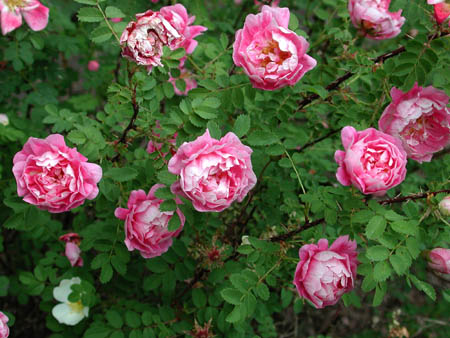
One of the Scots Roses known by the name 'Andrewsii'.
The problem is compounded because the same cultivar is sold under different names by different nurseries in Britain and abroad, different cultivars are sold under the same name and old cultivars that may have originated in Britain but have been 'found' in the gardens of other countries have been given new names in the language of the country concerned. Also, descriptive names such as 'Double White' or 'Double Pink' are accurate in their way, but there are several double white cultivars and numerous double pink ones. Several different cultivars are sold under the well-known names of 'Andrewsii', 'Mary Queen of Scots' and 'William III'. 'Glory of Edzell' is now one of the few cultivars that is normally supplied consistently named but I have not been able to find its origin. I have spoken to inhabitants of Edzell, near Brechin in Scotland who grow the cultivar but they purchased it from one of the well-known rose nurseries because of its name! I have discovered that there is a special interest in Scots Roses in Northern Europe, particularly in Denmark, Sweden and Finland. Their hardiness is particularly valued in Finland and probably more cultivars and hybrids of Rosa spinosissima are currently sold by nurseries there than anywhere else. Many of these cultivars (except 'Poppius') have been 'found' in old gardens and given a new Finnish name. Probably the majority were introduced from Britain in the nineteenth century but, as in Britain, the original names have been lost. Unfortunately, very few of the hundreds of Scots Roses the names of which I have found in old books and nursery catalogues were described sufficiently well or were so uniquely distinct to be able to give an old name to a 'found' cultivar with certainty. The naming of Scots Roses is a problem and sometimes the only thing to do may be to describe a particular variety accurately and give it a new name based on that description and illustrations. There is also a difference in the way that botanists and gardeners may describe an individual or a group of plants. Gardeners may be familiar with a particular cultivar of a species in cultivation and not realise that, in the wild, the species that they think they know is far less well defined and far more variable.
The bicoloured buds of one of the roses known by the name 'Mary Queen of Scots'.
There are a number of characters that may be used to help distinguish between one cultivar and another. Those cultivars may be selections from within the normal range of variation within the species or they may have characters introduced through hybridisation, with the characteristics of another species (or more than one species) complicating the picture. It is difficult to know how many of the Scots Roses that have been named are the result of variation, mutations or sports within the species and how many have arisen as natural hybrids in the wild, hybrids brought about by bees accidentally carrying out cross-pollination in the garden or nursery environment and how many were brought about by intentional crossing of one species or cultivar with another. The number of naturally occurring hybrids with Rosa spinosissima will be limited by the number of rose species that share its distribution and the number of those species that flower at the same time. A species which flowers a month later than Rosa spinosissima is less likely to produce a natural hybrid with that species in a normal season than one whose flowering period overlaps with that of R. spinosissima. Of course, in the garden or nursery it is possible for rose species to cross-pollinate which do not have the same natural distribution. Also, through manipulation of the flowering period with greenhouses, preservation of pollen or other manipulations, it becomes possible to cross-pollinate species or cultivars that normally flower at different times. However, probably, most older rose hybrids have arisen through pollination of plants flowering at the same time. Therefore, this may help in the process of deducing what parentage may have been involved - especially if some combinations could not have occurred because the date of introduction of a possible species post-dated the likely production of the hybrid. The use of modern DNA analytical techniques will, hopefully, clarify the parentage of some Scots Rose cultivars in future.
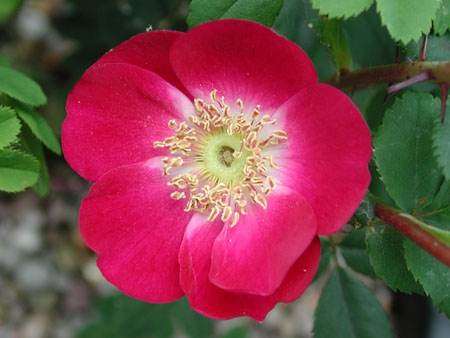
'Mrs Colville', a R. spinosissima x R. pendulina hybrid.
Public Collections of Scots Roses
Although I have developed a fairly large personal collection in the course of my research, there is no large public collection of Scots Roses in Scotland or elsewhere in Britain although many National Trust for Scotland properties have a few cultivars. Properties in Britain that had large collections in the 19th century now have few or none. Crathes Castle, west of Aberdeen, Scotland is one of my favourite gardens with several well-established cultivars of Scots Roses. Nearby Drum Castle has developed an attractive walled rose garden over the last few years with a good selection of mainly those Scots Roses that are available from nurseries. However, the small village of Kinnaird near Dundee, Scotland can probably still boast the most interesting collection which was made by Dr Peter Waister, his wife and other enthusiasts some thirty years ago in a garden that has become a small public park managed by Perth and Kinross Council. Unfortunately, the collection is now mostly unlabelled but it is well worth a visit in June. The old garden of the Royal National Rose Society near St. Albans in England was destroyed in 2004 and a new rose garden is being created on a site nearby. It remains to be seen how many Scots Roses will be displayed in the new garden.
However, it was clear to me, when I visited it in May 2004, that the Europa-Rosarium at Sangerhausen is flourishing. The roses are mainly grown in groups according to their 'class' such as Alba, Bourbon, Damask or Gallica. Although the Scots Roses would comprise a separate 'class' in Britain, they are not treated in this way in German rose books or at the Rosarium. However, the wonderful collection of 'wild roses' in the Rosarium contains not only distinct coloured forms but also many other cultivars of Rosa spinosissima with single white or cream flowers. Some of the latter look superficially very similar and I found the Sangerhausen experience very valuable in forcing me to look for distinguishing characters that one might otherwise ignore. During the few days that I was at the Rosarium, I worked with Hella Brumme (Director), Thomas Havel (Deputy Director) and Volker Wissemann examining each rose about which there was a question, writing a description with details of discriminatory characters such as variations in the density of thorns and bristles and taking photographs of details where possible. Fortunately, the weather was fine but not too hot. Unfortunately, it was too early for some cultivars to be in flower and too early to be able to record the colour and shape of the mature heps of the other cultivars. The heps can help to identify hybrids and give a clue to parentage.
As well as trying to use physical botanical characters that a gardener could recognise, I found that the scent or smell could provide a clue to parentage. The hint of or distinct scent of Rosa foetida was unmistakable not only in double and single yellow or cream cultivars but also in some single white cultivars, otherwise indistinguishable at first sight from Rosa spinosissima. In other cultivars, the presence of glands with a spicy or fruity odour on buds and stalks provided a distinctive character absent in other cultivars. I examined some of my own plants with a new insight when I returned home to my own collection. I am planning to return to the Europa –Rosarium in 2006 and hope that, by that time, I will be able to see some Scots Roses from my own collection growing there!
Cultivation notes
Scots Roses are not particular about soil and will grow in anything from clay to almost pure sand (as they do in sand-dunes which is their natural habitat). They grow well in poor sandy, stony soils where other roses might be unhappy. However, they will benefit from well-rotted manure under but not touching the roots when planted and a top dressing of well-rotted manure in the spring. The flowers will be even more abundant and the flower colour richer for this. They like full exposure to the sun and will grow more naturally and flower better if not shaded for more than a small part of the day. Most nurseries in Britain supply Scots Roses budded onto a rootstock but these roses grow more naturally and live longer (indefinitely) if growing on their own roots. Therefore, plant them deeper than you might do for other roses, with the union of the cultivar with the rootstock well below soil level. In this way, any suckers that grow should be from the Scots Rose and it will have the growth habit that is natural for the particular cultivar. Some cultivars form a low rounded mound of growth while others are taller, do not tend to sucker so much and have an arching form of growth. Scots Roses do not normally need pruning and those in which their natural form is to provide arching sprays of flowers will be spoilt if you do. However, others that naturally have a fairly rounded shape, will respond well to light pruning or clipping over with shears immediately after flowering and attractive hedges can be created from them. However, clipping after flowering removes the heps so that you will lose that attractive feature of late summer and autumn. Moreover, if the pruning or clipping is delayed you will cut off the growth that will flower next spring and you will miss a year's flowering.
Suckers (root-shoots) are a natural way of life for Scots Roses and provide an easy way of increasing your stock or of sharing a particular rose with friends. If you plant your Scots Roses with space around them and plenty of light the suckers will stay closer to the parent plant and form a slowly spreading mound of growth. If you plant herbaceous or other plants close to them, the suckers will grow longer until they emerge where there is light – at the front of the border! If you cover the ground with landscape fabric or black polythene and gravel or bark chips to suppress weeds, the suckers will keep travelling until they find a join or the edge where there is light! If you just use the bark chips or gravel without polythene or fabric, there will be less problem. Do not let this suckering habit put you off. It is easy to chop excess suckers off with a spade if you do not want them but if you want to propagate the plant, wait until autumn or spring to dig up the sucker carefully and transplant it or pot it up. I have found that Scots Roses do well in large pots (20 litres or more) for two or three years. This allows you to move a plant or small collection of Scots Roses closer to the house when it or they are in full flower. I started to grow Scots Roses on in pots before planting in the open ground when I found that a planned planting scheme could be ruined if a rose bought under a particular name was not what you expected. I also find that when I am give a sucker or suckers of a Scots Rose that is 'new' to me, it is easier to nurture them in pots until well enough established to plant out.
Conclusion
Relatively few Scots Roses are now available compared with the hundreds obtainable in the past but gardens everywhere should have one or two - at least. They can provide an enormous amount of pleasure in appearance, scent and their associated histories.
Further reading:
Boyd, P.D.A. (2004 a): Scots Roses: a new look at an exuberant group. Historic Rose Journal No. 28, Autumn 2004, The Royal National Rose Society, pp. 2-11 (web version available at http://www.peterboyd.com/rosapimp3.htm).
Boyd, P.D.A. (2004b): Mary McMurtrie, painter of Scots Roses. Historic Rose Journal Royal National Rose Society. No. 28 Autumn 2004 p. 7. (web version available at http://www.peterboyd.com/mcmurtrie.htm ).
Boyd, P.D.A. (2004c): Scots Roses in Europe and the Europa-Rosarium at Sangerhausen in Germany. NCCPG Shropshire Group Newsletter Autumn 2004. (web version available at http://www.peterboyd.com/sangerhausen04.htm ).
Boyd, P.D.A. (2005): Scots Roses for Scottish Gardens. The Scottish Garden. Spring 2005.
McMurtrie, M. (1998): Scots Roses of hedgerows and wild gardens. Antique Collectors Club, Woodbridge.